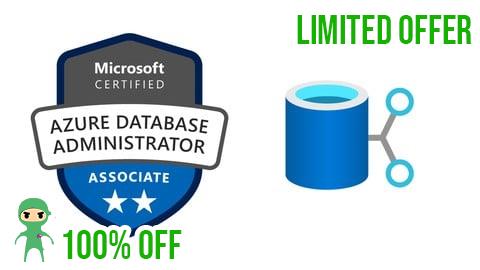
This highly-rated course boasts a 5.0-star-star rating from 0 reviews and has successfully guided 1,064 students in mastering IT Certifications skills. Featuring of expert-led content delivered in English, this course offers thorough training to enhance your Social Science expertise. The course details were last updated on December 24, 2024. This coupon code is brought to you by Anonymous.
- Expired on July 03, 2025
- Last Update: July 03, 2025
-
Price:
0.00 $
About This Course
Skills at a glance
Plan and implement data platform resources (20–25%)
Implement a secure environment (15–20%)
Monitor, configure, and optimize database resources (20–25%)
Configure and manage automation of tasks (15–20%)
Plan and configure a high availability and disaster recovery (HA/DR) environment (20–25%)
Plan and implement data platform resources (20–25%)
Plan and deploy Azure SQL solutions
Deploy database offerings on selected platforms
Understand automated deployment
Apply patches and updates for hybrid and infrastructure as a service (IaaS) deployment
Deploy hybrid SQL Server solutions
Recommend an appropriate database offering based on specific requirements
Evaluate the security aspects of the possible database offering
Recommend a table partitioning solution
Recommend a database sharding solution
Configure resources for scale and performance
Configure Azure SQL Database for scale and performance
Configure Azure SQL Managed Instance for scale and performance
Configure SQL Server on Azure Virtual Machines for scale and performance
Configure table partitioning
Configure data compression
Plan and implement a migration strategy
Evaluate requirements for the migration
Evaluate offline or online migration strategies
Implement an online migration strategy
Implement an offline migration strategy
Perform post migration validations
Troubleshoot a migration
Set up SQL Data Sync for Azure
Implement a migration to Azure
Implement a migration between Azure SQL services
Implement Azure SQL Managed Instance database copy and move
Implement a secure environment (15–20%)
Configure database authentication and authorization
Configure authentication by using Active Directory and Microsoft Entra ID
Create users from Microsoft Entra identities
Configure security principals
Configure database and object-level permissions using graphical tools
Apply the principle of least privilege for all securables
Troubleshoot authentication and authorization issues
Manage authentication and authorization by using T-SQL
Implement security for data at rest and data in transit
Implement transparent data encryption (TDE)
Implement object-level encryption
Configure server- and database-level firewall rules
Implement Always Encrypted
Implement Always Encrypted with VBS enclaves
Configure secure access
Configure Transport Layer Security (TLS)
Implement compliance controls for sensitive data
Apply a data classification strategy
Configure server and database audits
Implement data change tracking
Implement dynamic data masking
Manage database resources by using Microsoft Purview
Implement database ledger in Azure SQL
Implement row-level security
Configure Microsoft Defender for Azure SQL
Monitor, configure, and optimize database resources (20–25%)
Monitor resource activity and performance
Prepare an operational performance baseline
Determine sources for performance metrics
Interpret performance metrics
Configure and monitor activity and performance
Monitor by using SQL Insights
Monitor by using database watcher
Monitor by using Extended Events
Monitor and optimize query performance
Configure Query Store
Monitor by using Query Store
Identify sessions that cause blocking
Identify performance issues using dynamic management views (DMVs)
Identify and implement index changes for queries
Recommend query construct modifications based on resource usage
Assess the use of query hints for query performance
Review execution plans
Monitor by using Intelligent Insights
Configure database solutions for optimal performance
Implement index maintenance tasks
Implement statistics maintenance tasks
Implement database integrity checks
Configure database automatic tuning
Configure server settings for performance
Configure Resource Governor for performance
Implement database-scoped configuration
Configure compute and storage resources for scaling
Configure intelligent query processing (IQP)
Configure and manage automation of tasks (15–20%)
Create and manage SQL Server Agent jobs
Manage schedules for regular maintenance jobs
Configure job alerts and notifications
Troubleshoot SQL Server Agent jobs
Automate deployment of database resources
Automate deployment by using Azure Resource Manager (ARM) and Bicep templates
Automate deployment by using PowerShell
Automate deployment by using Azure CLI
Monitor and troubleshoot deployments
Create and manage database tasks in Azure
Create and configure elastic jobs
Create and configure database tasks by using automation
Configure alerts and notifications on database tasks
Troubleshoot automated database tasks
Plan and configure a high availability and disaster recovery (HA/DR) environment (20–25%)
Recommend an HA/DR strategy for database solutions
Recommend HA/DR strategy based on Recovery Point Objective/Recovery Time Objective (RPO/RTO) requirements
Evaluate HA/DR for hybrid deployments
Evaluate Azure-specific HA/DR solutions
Recommend a testing procedure for an HA/DR solution
Plan and perform backup and restore of a database
Recommend a database backup and restore strategy
Perform a database backup by using database tools
Perform a database restore by using database tools
Perform a database restore to a point in time
Configure long-term backup retention
Backup and restore a database by using T-SQL
Backup and restore to and from cloud storage
Configure HA/DR for database solutions
Configure active geo-replication
Configure an Always On availability group on Azure virtual machines
Configure failover groups
Configure quorum options for a Windows Server Failover Cluster
Configure Always On Failover Cluster Instances on Azure virtual machines
Configure log shipping
Monitor an HA/DR solution
Troubleshoot an HA/DR solution











